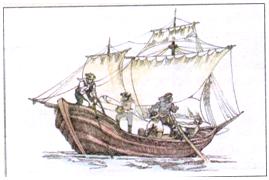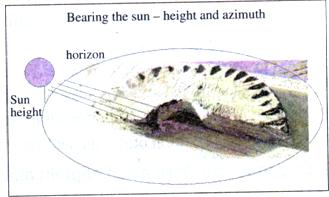-
(单词翻译:双击或拖选)
We may well wonder how seamen1 explored the oceans before latitude2 and longitude3 made it possible to plot a ship's position on a map. The voyages of travellers before the 17th century show that they were not at the mercy of the sea even though they did not have modern navigational aids. So how did they navigate4 so well? Read these pages from an encyclopedia5.
Page 1:
Using nature to help Keeping alongside the coastline
This seems to have been the first and most useful form of exploration which carried the minimum amount of risk.
North Star
At the North Pole the North Star is at its highest position in the sky, but at the equator it is along the horizon. So accomplished7 navigators were able to use it to plot their positions.
Sun
On a clear day especially during the summer the sailors could use the sun overhead at midday to navigate by. They can use the height of the sun to work out their latitude.
Clouds
Sea captains observed the clouds over islands. There is a special cloud formation which indicates there is land close by.
Using wildlife
Seaweed
Sailors often saw seaweed in the sea and could tell by the colour and smell how long it had been them. If it was fresh and smelled strongly,then the ship was close to land.
Birds
Sea birds could be used to show the way to land when it was nowhere to be seen. In the evening nesting birds return to land and their nests. So seamen could follow the birds to land even if they were offshore8 and in the open sea.
Using the weather
Fog
Fog gathers at sea as well as over streams or rivers. Seamen used it to help identify the position of a stream or river when they were close to land.
Winds
Wise seamen used the winds to direct their sailing. They could accelerate the speed, but they could also be dangerous. So the Vikings would observe the winds before and during their outward or return journeys.
Using the sea
Certain tides and currents could be used by skillful sailors to carry ships to their destination.These skills helped sailors explore the seas and discover new lands. They increased their ability to navigate new seas when they used instruments.
Page 2:
Using navigational instruments to help
Finding longitude
There was no secure method of measuring longitude until the 17th century when the British solved this theoretical problem. Nobody knew that the earth moved westwards 15 degrees every hour, but sailors did know an approximate method of calculating longitude using speed and time. An early method of measuring speed involved throwing a knotted rope tied to a log over the side of the ship. The rope was tied to a log which was then thrown into the sea. As the ship advanced through the water the knots were counted as they passed through a seaman9's hands. The number of knots that were counted during a fixed10 period of time gave the speed of the ship in nautical11 miles per hour.

Later, when seamen began to use the compass in the 12th century they could calculate longitude using complicated mathematical tables. The compass has a special magnetic pointer which always indicates the North Pole, so it is used to help find the direction that the ship needs to go. In this way the ship could set a straight course even in the middle of the ocean.
Finding latitude
The Bearing Circle
It was the first instrument to measure the sun's position. A seaman would measure the sun's shadow and compare it with the height of the sun at midday. Then he could tell if he was sailing on his correct rather than a random12 course.

A Bearing Circle
The Astrolabe
The astrolabe, quadrant and sextant are all connected. They are developments of one another. The earliest, the astrolabe, was a special all-in-one tool for telling the position of the ship in relation to the sun and various stars which covered the whole sky. This gave the seamen the local time and allowed them to find their latitude at sea. However, it was awkward to use as one of the points of reference was the moving ship itself.
The Quadrant
This was a more precise and simplified version of the astrolabe. It measured how high stars were above the horizon using a quarter circle rather than the full circle of the astrolabe.It was easier to handle because it was more portable. Its shortcoming was that it still used the moving ship as one of the fixed points of reference. As the ship rose and plunged13 in the waves, it was extremely difficult to be accurate with any reading.
The sextant
The sextant was the updated version of the astrolabe and quadrant which reduced the tendency to make mistakes. It proved to be the most accurate and reliable of these early navigational instruments. It works by measuring the angle between two fixed objects outside the ship using two mirrors. This made the calculations more precise and easier to do
点击 收听单词发音
收听单词发音
 收听单词发音
收听单词发音
1
seamen

|
|
| n.海员 | |
参考例句: |
|
|
|
2
latitude

|
|
| n.纬度,行动或言论的自由(范围),(pl.)地区 | |
参考例句: |
|
|
|
3
longitude

|
|
| n.经线,经度 | |
参考例句: |
|
|
|
4
navigate

|
|
| v.航行,飞行;导航,领航 | |
参考例句: |
|
|
|
5
encyclopedia

|
|
| n.百科全书 | |
参考例句: |
|
|
|
6
celestial

|
|
| adj.天体的;天上的 | |
参考例句: |
|
|
|
7
accomplished

|
|
| adj.有才艺的;有造诣的;达到了的 | |
参考例句: |
|
|
|
8
offshore

|
|
| adj.海面的,吹向海面的;adv.向海面 | |
参考例句: |
|
|
|
9
seaman

|
|
| n.海员,水手,水兵 | |
参考例句: |
|
|
|
10
fixed

|
|
| adj.固定的,不变的,准备好的;(计算机)固定的 | |
参考例句: |
|
|
|
11
nautical

|
|
| adj.海上的,航海的,船员的 | |
参考例句: |
|
|
|
12
random

|
|
| adj.随机的;任意的;n.偶然的(或随便的)行动 | |
参考例句: |
|
|
|
13
plunged

|
|
| v.颠簸( plunge的过去式和过去分词 );暴跌;骤降;突降 | |
参考例句: |
|
|
|

















